LSBM303 - Hmlet's Internationalization: Growth and Challenges
VerifiedAdded on 2023/06/18
|9
|2795
|322
Case Study
AI Summary
This report critically examines Hmlet's internationalization strategy, focusing on its expansion into Singapore, Hong Kong, and Tokyo. It identifies key drivers such as organizational structure, financial resources, local market considerations, and risk management. Using the Ansoff matrix, the report analyzes Hmlet's market penetration, product development, market development, and diversification strategies. Furthermore, it discusses the challenges Hmlet faces in Asian markets, including rising energy costs, housing shortages, fossil fuel dependence, and workforce limitations, particularly concerning sustainability. The report proposes solutions such as adopting solar energy, seeking strategic partnerships, and investing in AI to mitigate these challenges and establish Hmlet as a leading player in the co-living service market. Desklib provides access to similar solved assignments and past papers to aid students in their studies.
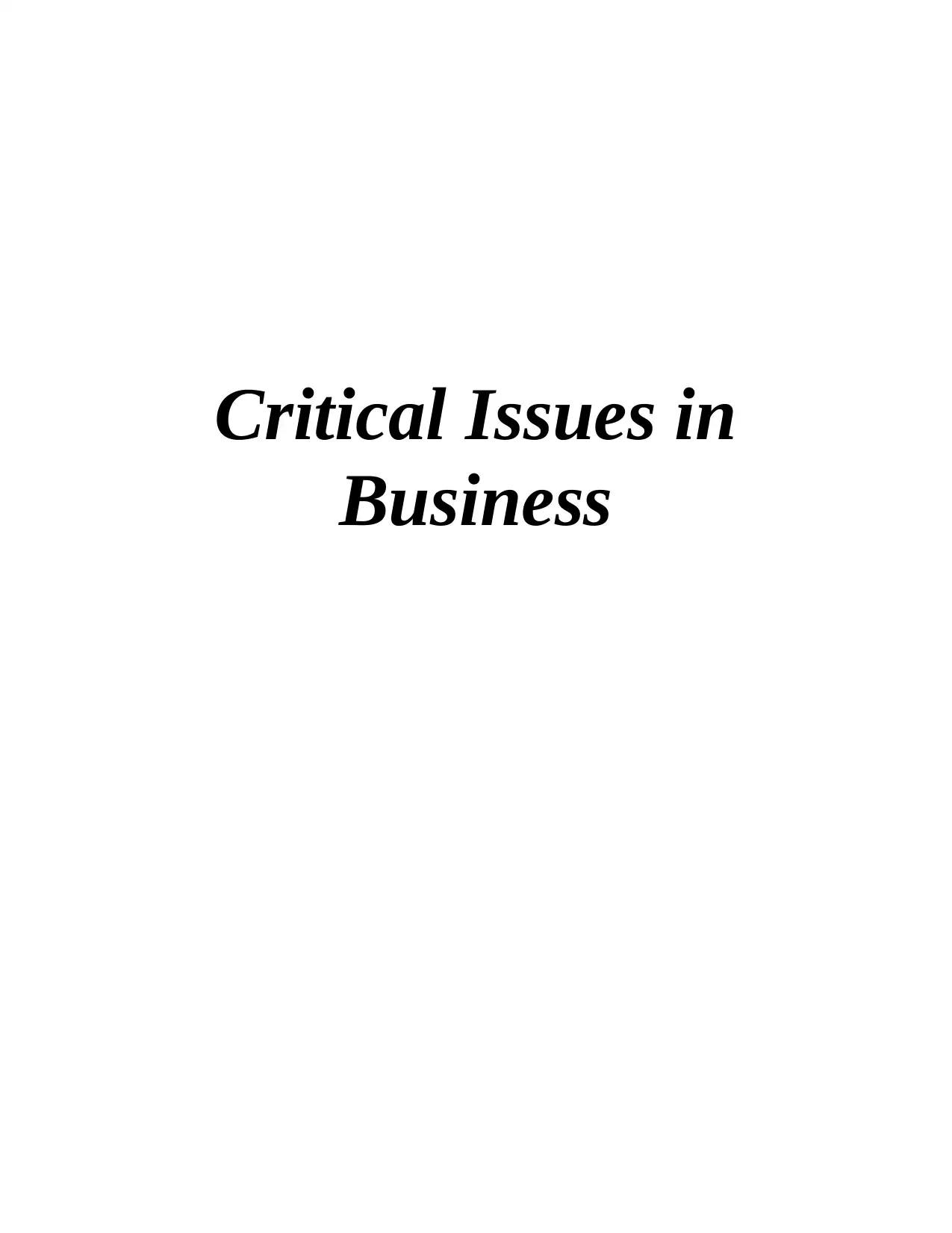
Critical Issues in
Business
Business
Paraphrase This Document
Need a fresh take? Get an instant paraphrase of this document with our AI Paraphraser

Table of Contents
INTRODUCTION ..........................................................................................................................3
PART 1............................................................................................................................................3
What are the main drivers for the internationalisation for Hmlet?.............................................3
PART 2............................................................................................................................................5
Critically analyse Hmlet’s international growth strategy for Singapore, Hong Kong and Tokyo
.....................................................................................................................................................5
PART 3............................................................................................................................................6
Discuss the possible challenges Hmlet could face in Asian markets going forward including
.....................................................................................................................................................6
sustainability. What should Hmlet do to emerge as a strong player in the co-living space
.....................................................................................................................................................6
service market.............................................................................................................................6
CONCLUSION ...............................................................................................................................8
REFERENCES................................................................................................................................9
INTRODUCTION ..........................................................................................................................3
PART 1............................................................................................................................................3
What are the main drivers for the internationalisation for Hmlet?.............................................3
PART 2............................................................................................................................................5
Critically analyse Hmlet’s international growth strategy for Singapore, Hong Kong and Tokyo
.....................................................................................................................................................5
PART 3............................................................................................................................................6
Discuss the possible challenges Hmlet could face in Asian markets going forward including
.....................................................................................................................................................6
sustainability. What should Hmlet do to emerge as a strong player in the co-living space
.....................................................................................................................................................6
service market.............................................................................................................................6
CONCLUSION ...............................................................................................................................8
REFERENCES................................................................................................................................9
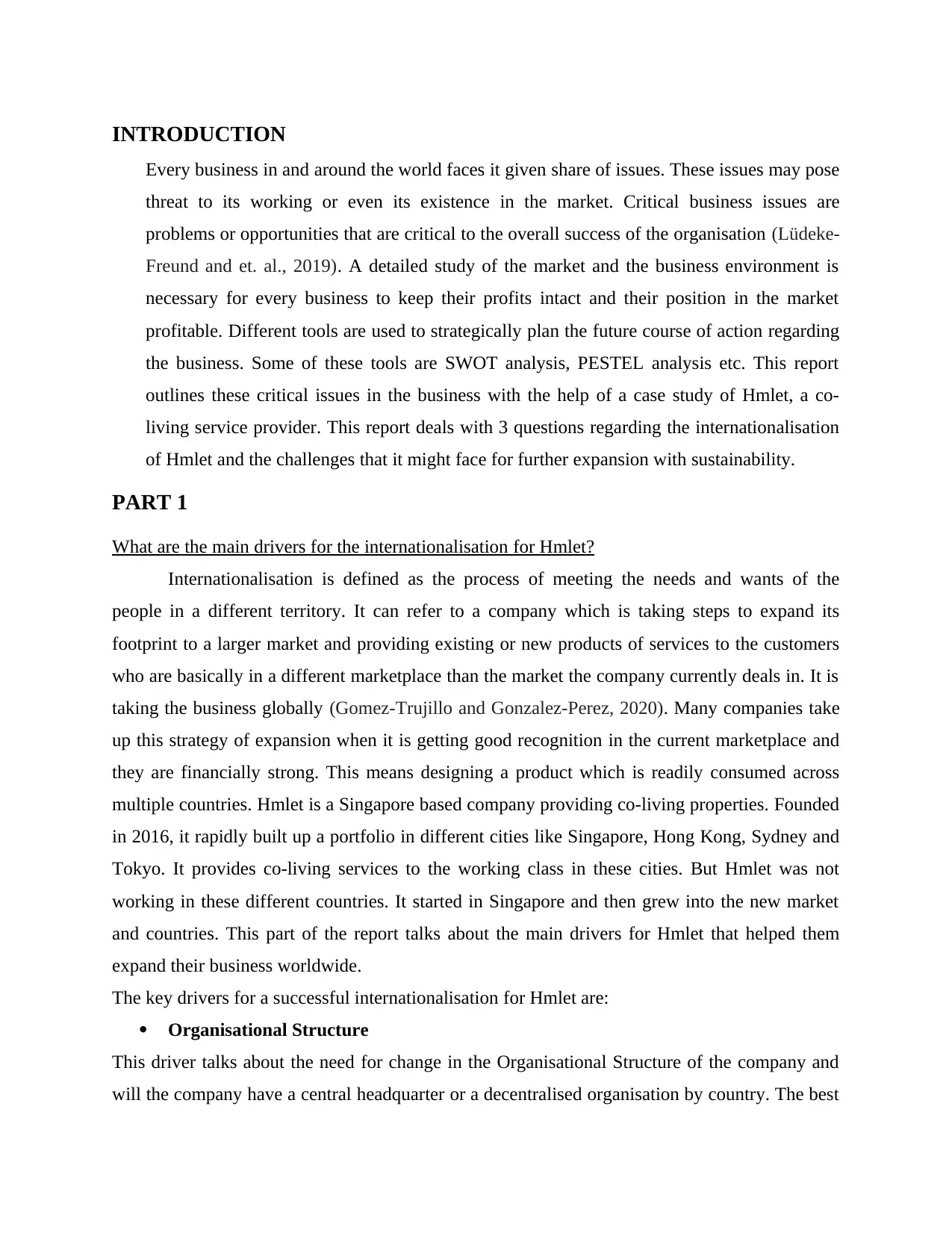
INTRODUCTION
Every business in and around the world faces it given share of issues. These issues may pose
threat to its working or even its existence in the market. Critical business issues are
problems or opportunities that are critical to the overall success of the organisation (Lüdeke-
Freund and et. al., 2019). A detailed study of the market and the business environment is
necessary for every business to keep their profits intact and their position in the market
profitable. Different tools are used to strategically plan the future course of action regarding
the business. Some of these tools are SWOT analysis, PESTEL analysis etc. This report
outlines these critical issues in the business with the help of a case study of Hmlet, a co-
living service provider. This report deals with 3 questions regarding the internationalisation
of Hmlet and the challenges that it might face for further expansion with sustainability.
PART 1
What are the main drivers for the internationalisation for Hmlet?
Internationalisation is defined as the process of meeting the needs and wants of the
people in a different territory. It can refer to a company which is taking steps to expand its
footprint to a larger market and providing existing or new products of services to the customers
who are basically in a different marketplace than the market the company currently deals in. It is
taking the business globally (Gomez-Trujillo and Gonzalez-Perez, 2020). Many companies take
up this strategy of expansion when it is getting good recognition in the current marketplace and
they are financially strong. This means designing a product which is readily consumed across
multiple countries. Hmlet is a Singapore based company providing co-living properties. Founded
in 2016, it rapidly built up a portfolio in different cities like Singapore, Hong Kong, Sydney and
Tokyo. It provides co-living services to the working class in these cities. But Hmlet was not
working in these different countries. It started in Singapore and then grew into the new market
and countries. This part of the report talks about the main drivers for Hmlet that helped them
expand their business worldwide.
The key drivers for a successful internationalisation for Hmlet are:
Organisational Structure
This driver talks about the need for change in the Organisational Structure of the company and
will the company have a central headquarter or a decentralised organisation by country. The best
Every business in and around the world faces it given share of issues. These issues may pose
threat to its working or even its existence in the market. Critical business issues are
problems or opportunities that are critical to the overall success of the organisation (Lüdeke-
Freund and et. al., 2019). A detailed study of the market and the business environment is
necessary for every business to keep their profits intact and their position in the market
profitable. Different tools are used to strategically plan the future course of action regarding
the business. Some of these tools are SWOT analysis, PESTEL analysis etc. This report
outlines these critical issues in the business with the help of a case study of Hmlet, a co-
living service provider. This report deals with 3 questions regarding the internationalisation
of Hmlet and the challenges that it might face for further expansion with sustainability.
PART 1
What are the main drivers for the internationalisation for Hmlet?
Internationalisation is defined as the process of meeting the needs and wants of the
people in a different territory. It can refer to a company which is taking steps to expand its
footprint to a larger market and providing existing or new products of services to the customers
who are basically in a different marketplace than the market the company currently deals in. It is
taking the business globally (Gomez-Trujillo and Gonzalez-Perez, 2020). Many companies take
up this strategy of expansion when it is getting good recognition in the current marketplace and
they are financially strong. This means designing a product which is readily consumed across
multiple countries. Hmlet is a Singapore based company providing co-living properties. Founded
in 2016, it rapidly built up a portfolio in different cities like Singapore, Hong Kong, Sydney and
Tokyo. It provides co-living services to the working class in these cities. But Hmlet was not
working in these different countries. It started in Singapore and then grew into the new market
and countries. This part of the report talks about the main drivers for Hmlet that helped them
expand their business worldwide.
The key drivers for a successful internationalisation for Hmlet are:
Organisational Structure
This driver talks about the need for change in the Organisational Structure of the company and
will the company have a central headquarter or a decentralised organisation by country. The best
⊘ This is a preview!⊘
Do you want full access?
Subscribe today to unlock all pages.

Trusted by 1+ million students worldwide
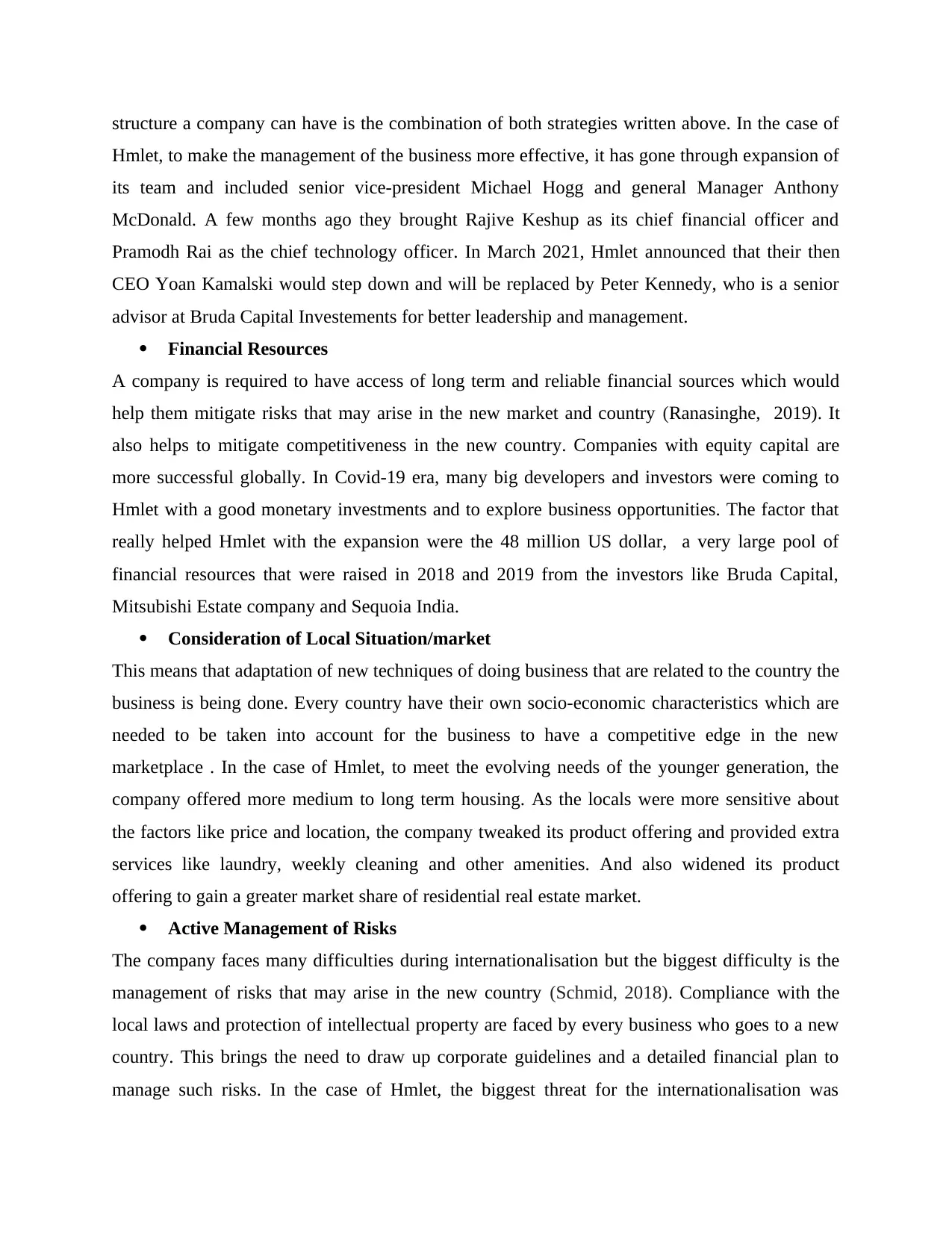
structure a company can have is the combination of both strategies written above. In the case of
Hmlet, to make the management of the business more effective, it has gone through expansion of
its team and included senior vice-president Michael Hogg and general Manager Anthony
McDonald. A few months ago they brought Rajive Keshup as its chief financial officer and
Pramodh Rai as the chief technology officer. In March 2021, Hmlet announced that their then
CEO Yoan Kamalski would step down and will be replaced by Peter Kennedy, who is a senior
advisor at Bruda Capital Investements for better leadership and management.
Financial Resources
A company is required to have access of long term and reliable financial sources which would
help them mitigate risks that may arise in the new market and country (Ranasinghe, 2019). It
also helps to mitigate competitiveness in the new country. Companies with equity capital are
more successful globally. In Covid-19 era, many big developers and investors were coming to
Hmlet with a good monetary investments and to explore business opportunities. The factor that
really helped Hmlet with the expansion were the 48 million US dollar, a very large pool of
financial resources that were raised in 2018 and 2019 from the investors like Bruda Capital,
Mitsubishi Estate company and Sequoia India.
Consideration of Local Situation/market
This means that adaptation of new techniques of doing business that are related to the country the
business is being done. Every country have their own socio-economic characteristics which are
needed to be taken into account for the business to have a competitive edge in the new
marketplace . In the case of Hmlet, to meet the evolving needs of the younger generation, the
company offered more medium to long term housing. As the locals were more sensitive about
the factors like price and location, the company tweaked its product offering and provided extra
services like laundry, weekly cleaning and other amenities. And also widened its product
offering to gain a greater market share of residential real estate market.
Active Management of Risks
The company faces many difficulties during internationalisation but the biggest difficulty is the
management of risks that may arise in the new country (Schmid, 2018). Compliance with the
local laws and protection of intellectual property are faced by every business who goes to a new
country. This brings the need to draw up corporate guidelines and a detailed financial plan to
manage such risks. In the case of Hmlet, the biggest threat for the internationalisation was
Hmlet, to make the management of the business more effective, it has gone through expansion of
its team and included senior vice-president Michael Hogg and general Manager Anthony
McDonald. A few months ago they brought Rajive Keshup as its chief financial officer and
Pramodh Rai as the chief technology officer. In March 2021, Hmlet announced that their then
CEO Yoan Kamalski would step down and will be replaced by Peter Kennedy, who is a senior
advisor at Bruda Capital Investements for better leadership and management.
Financial Resources
A company is required to have access of long term and reliable financial sources which would
help them mitigate risks that may arise in the new market and country (Ranasinghe, 2019). It
also helps to mitigate competitiveness in the new country. Companies with equity capital are
more successful globally. In Covid-19 era, many big developers and investors were coming to
Hmlet with a good monetary investments and to explore business opportunities. The factor that
really helped Hmlet with the expansion were the 48 million US dollar, a very large pool of
financial resources that were raised in 2018 and 2019 from the investors like Bruda Capital,
Mitsubishi Estate company and Sequoia India.
Consideration of Local Situation/market
This means that adaptation of new techniques of doing business that are related to the country the
business is being done. Every country have their own socio-economic characteristics which are
needed to be taken into account for the business to have a competitive edge in the new
marketplace . In the case of Hmlet, to meet the evolving needs of the younger generation, the
company offered more medium to long term housing. As the locals were more sensitive about
the factors like price and location, the company tweaked its product offering and provided extra
services like laundry, weekly cleaning and other amenities. And also widened its product
offering to gain a greater market share of residential real estate market.
Active Management of Risks
The company faces many difficulties during internationalisation but the biggest difficulty is the
management of risks that may arise in the new country (Schmid, 2018). Compliance with the
local laws and protection of intellectual property are faced by every business who goes to a new
country. This brings the need to draw up corporate guidelines and a detailed financial plan to
manage such risks. In the case of Hmlet, the biggest threat for the internationalisation was
Paraphrase This Document
Need a fresh take? Get an instant paraphrase of this document with our AI Paraphraser
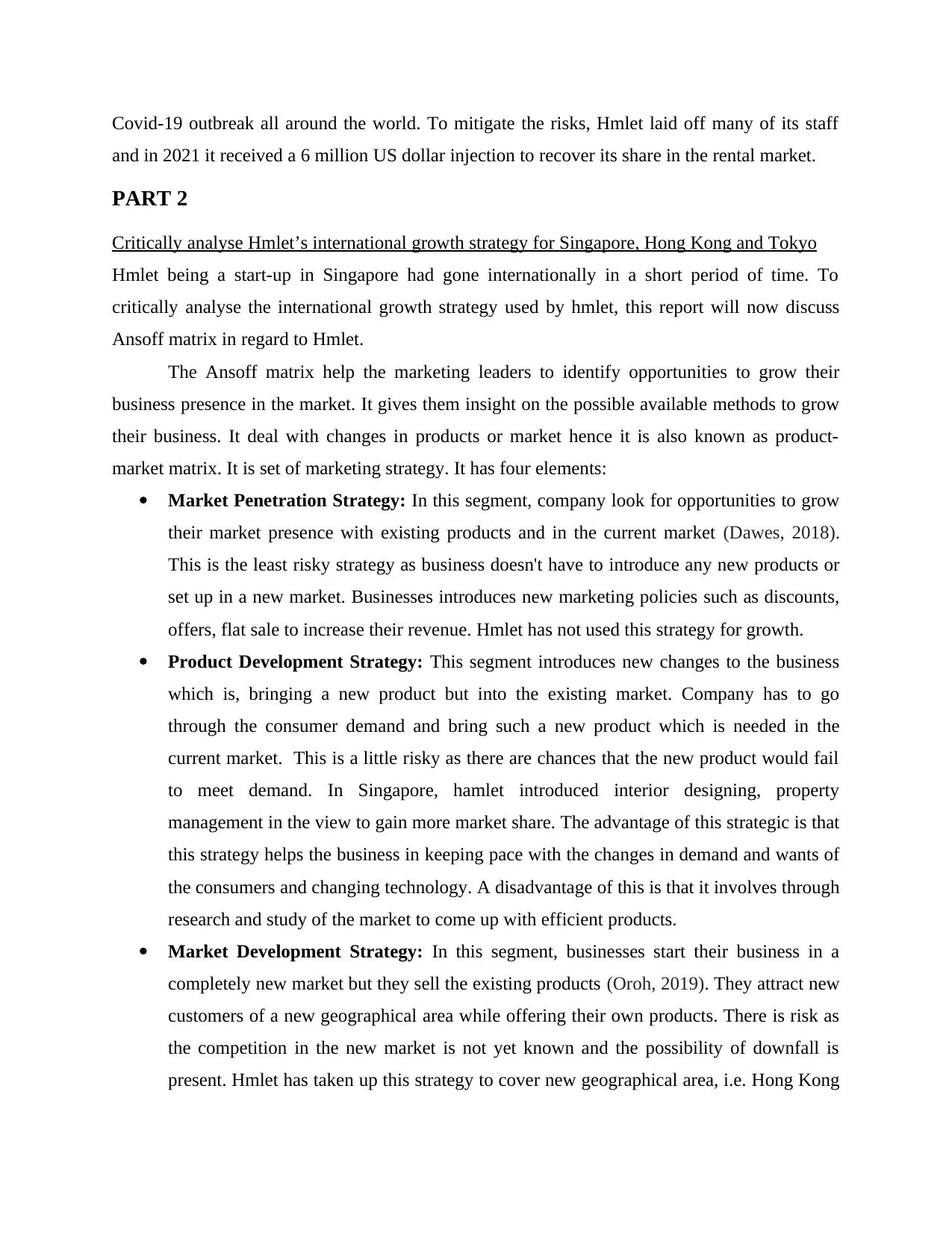
Covid-19 outbreak all around the world. To mitigate the risks, Hmlet laid off many of its staff
and in 2021 it received a 6 million US dollar injection to recover its share in the rental market.
PART 2
Critically analyse Hmlet’s international growth strategy for Singapore, Hong Kong and Tokyo
Hmlet being a start-up in Singapore had gone internationally in a short period of time. To
critically analyse the international growth strategy used by hmlet, this report will now discuss
Ansoff matrix in regard to Hmlet.
The Ansoff matrix help the marketing leaders to identify opportunities to grow their
business presence in the market. It gives them insight on the possible available methods to grow
their business. It deal with changes in products or market hence it is also known as product-
market matrix. It is set of marketing strategy. It has four elements:
Market Penetration Strategy: In this segment, company look for opportunities to grow
their market presence with existing products and in the current market (Dawes, 2018).
This is the least risky strategy as business doesn't have to introduce any new products or
set up in a new market. Businesses introduces new marketing policies such as discounts,
offers, flat sale to increase their revenue. Hmlet has not used this strategy for growth.
Product Development Strategy: This segment introduces new changes to the business
which is, bringing a new product but into the existing market. Company has to go
through the consumer demand and bring such a new product which is needed in the
current market. This is a little risky as there are chances that the new product would fail
to meet demand. In Singapore, hamlet introduced interior designing, property
management in the view to gain more market share. The advantage of this strategic is that
this strategy helps the business in keeping pace with the changes in demand and wants of
the consumers and changing technology. A disadvantage of this is that it involves through
research and study of the market to come up with efficient products.
Market Development Strategy: In this segment, businesses start their business in a
completely new market but they sell the existing products (Oroh, 2019). They attract new
customers of a new geographical area while offering their own products. There is risk as
the competition in the new market is not yet known and the possibility of downfall is
present. Hmlet has taken up this strategy to cover new geographical area, i.e. Hong Kong
and in 2021 it received a 6 million US dollar injection to recover its share in the rental market.
PART 2
Critically analyse Hmlet’s international growth strategy for Singapore, Hong Kong and Tokyo
Hmlet being a start-up in Singapore had gone internationally in a short period of time. To
critically analyse the international growth strategy used by hmlet, this report will now discuss
Ansoff matrix in regard to Hmlet.
The Ansoff matrix help the marketing leaders to identify opportunities to grow their
business presence in the market. It gives them insight on the possible available methods to grow
their business. It deal with changes in products or market hence it is also known as product-
market matrix. It is set of marketing strategy. It has four elements:
Market Penetration Strategy: In this segment, company look for opportunities to grow
their market presence with existing products and in the current market (Dawes, 2018).
This is the least risky strategy as business doesn't have to introduce any new products or
set up in a new market. Businesses introduces new marketing policies such as discounts,
offers, flat sale to increase their revenue. Hmlet has not used this strategy for growth.
Product Development Strategy: This segment introduces new changes to the business
which is, bringing a new product but into the existing market. Company has to go
through the consumer demand and bring such a new product which is needed in the
current market. This is a little risky as there are chances that the new product would fail
to meet demand. In Singapore, hamlet introduced interior designing, property
management in the view to gain more market share. The advantage of this strategic is that
this strategy helps the business in keeping pace with the changes in demand and wants of
the consumers and changing technology. A disadvantage of this is that it involves through
research and study of the market to come up with efficient products.
Market Development Strategy: In this segment, businesses start their business in a
completely new market but they sell the existing products (Oroh, 2019). They attract new
customers of a new geographical area while offering their own products. There is risk as
the competition in the new market is not yet known and the possibility of downfall is
present. Hmlet has taken up this strategy to cover new geographical area, i.e. Hong Kong
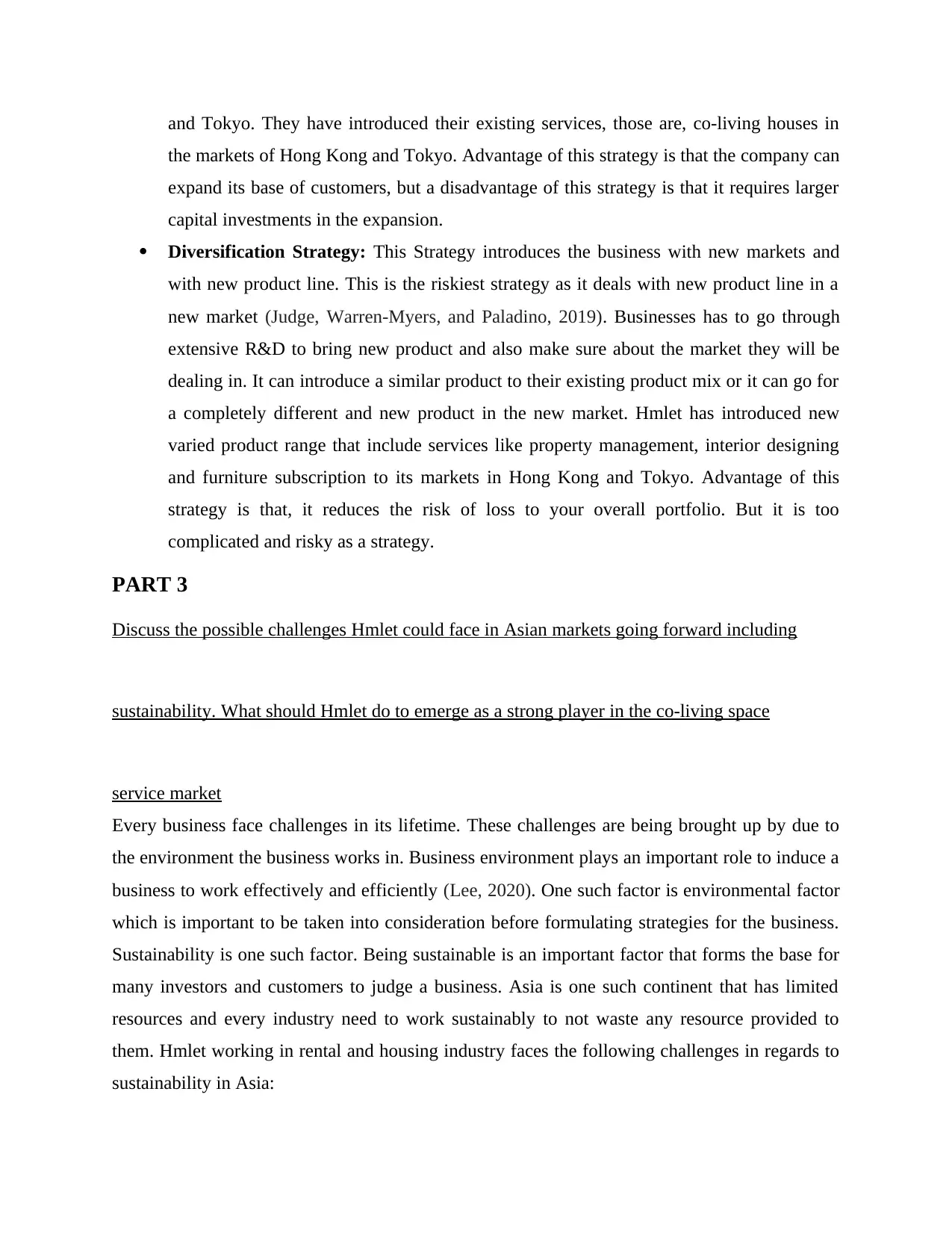
and Tokyo. They have introduced their existing services, those are, co-living houses in
the markets of Hong Kong and Tokyo. Advantage of this strategy is that the company can
expand its base of customers, but a disadvantage of this strategy is that it requires larger
capital investments in the expansion.
Diversification Strategy: This Strategy introduces the business with new markets and
with new product line. This is the riskiest strategy as it deals with new product line in a
new market (Judge, Warren-Myers, and Paladino, 2019). Businesses has to go through
extensive R&D to bring new product and also make sure about the market they will be
dealing in. It can introduce a similar product to their existing product mix or it can go for
a completely different and new product in the new market. Hmlet has introduced new
varied product range that include services like property management, interior designing
and furniture subscription to its markets in Hong Kong and Tokyo. Advantage of this
strategy is that, it reduces the risk of loss to your overall portfolio. But it is too
complicated and risky as a strategy.
PART 3
Discuss the possible challenges Hmlet could face in Asian markets going forward including
sustainability. What should Hmlet do to emerge as a strong player in the co-living space
service market
Every business face challenges in its lifetime. These challenges are being brought up by due to
the environment the business works in. Business environment plays an important role to induce a
business to work effectively and efficiently (Lee, 2020). One such factor is environmental factor
which is important to be taken into consideration before formulating strategies for the business.
Sustainability is one such factor. Being sustainable is an important factor that forms the base for
many investors and customers to judge a business. Asia is one such continent that has limited
resources and every industry need to work sustainably to not waste any resource provided to
them. Hmlet working in rental and housing industry faces the following challenges in regards to
sustainability in Asia:
the markets of Hong Kong and Tokyo. Advantage of this strategy is that the company can
expand its base of customers, but a disadvantage of this strategy is that it requires larger
capital investments in the expansion.
Diversification Strategy: This Strategy introduces the business with new markets and
with new product line. This is the riskiest strategy as it deals with new product line in a
new market (Judge, Warren-Myers, and Paladino, 2019). Businesses has to go through
extensive R&D to bring new product and also make sure about the market they will be
dealing in. It can introduce a similar product to their existing product mix or it can go for
a completely different and new product in the new market. Hmlet has introduced new
varied product range that include services like property management, interior designing
and furniture subscription to its markets in Hong Kong and Tokyo. Advantage of this
strategy is that, it reduces the risk of loss to your overall portfolio. But it is too
complicated and risky as a strategy.
PART 3
Discuss the possible challenges Hmlet could face in Asian markets going forward including
sustainability. What should Hmlet do to emerge as a strong player in the co-living space
service market
Every business face challenges in its lifetime. These challenges are being brought up by due to
the environment the business works in. Business environment plays an important role to induce a
business to work effectively and efficiently (Lee, 2020). One such factor is environmental factor
which is important to be taken into consideration before formulating strategies for the business.
Sustainability is one such factor. Being sustainable is an important factor that forms the base for
many investors and customers to judge a business. Asia is one such continent that has limited
resources and every industry need to work sustainably to not waste any resource provided to
them. Hmlet working in rental and housing industry faces the following challenges in regards to
sustainability in Asia:
⊘ This is a preview!⊘
Do you want full access?
Subscribe today to unlock all pages.

Trusted by 1+ million students worldwide

The increasing energy costs and poverty is widespread in Asian continent, this will make
it hard for the customers to pay off the rent and for Hmlet to reduce costs of living.
In the Asian continent, the urban areas are in shortage of housing due to overpopulation
and limited area. Big cities like Tokyo, Thailand face these problems and this increasing
demand makes investments too huge and revenue too less.
As the infrastructure needs the use of gas, electricity the fossil dependence in the housing
industry remains unacceptably large (Balasubramanian and et. al., 2021). Which could
pose a threat to the normal working of the business for Hmlet.
Housing Industry directly depends on construction industry and the shortage of the work
force that will only increase in the future poses a real threat to Hmlet as it depends on
infrastructure firms.
The above mentioned challenges are faced by Hmlet in the rental and housing industry in Asia.
The main solution to reduce the impact of these challenges is to adopt sustainable practices and
have a competitive advantage in the industry. Following are the possible solutions for Hmlet to
emerge as a leading player in the service market:
The solution to first challenge that is being discussed above is that Hmlet needs to find
ways to reduce the energy costs that are increasing and posing a threat to the revenue. To
reduce costs, Hmlet should take up sustainable practices like using solar energy in its
activities would result in less costs and more revenue. It also creates good image in front
of the stakeholders of a business.
To reduce the investments cost, Hmlet need to look up the ways through which it can
raise funds and work efficiently. Either it should make new public offering to raise funds
or come into partnerships with other businesses who are working in the same industry.
Use of solar and hydro energy is an efficient way to reduce the risks related to fossil
dependence.
Investing in the AI will be efficient for the construction industry as the work force is
declining. Machine that can work effectively and efficiently should be used.
Hmlet alone, need to come up with such strategies that will give a competitive advantage
in the co-living space market. It needs to critically analyse the market and the needs and wants of
the customers. As it mainly provides the renting house to the working people, it can introduce the
facility of order food or provide food to these people as they might want this service. It can also
it hard for the customers to pay off the rent and for Hmlet to reduce costs of living.
In the Asian continent, the urban areas are in shortage of housing due to overpopulation
and limited area. Big cities like Tokyo, Thailand face these problems and this increasing
demand makes investments too huge and revenue too less.
As the infrastructure needs the use of gas, electricity the fossil dependence in the housing
industry remains unacceptably large (Balasubramanian and et. al., 2021). Which could
pose a threat to the normal working of the business for Hmlet.
Housing Industry directly depends on construction industry and the shortage of the work
force that will only increase in the future poses a real threat to Hmlet as it depends on
infrastructure firms.
The above mentioned challenges are faced by Hmlet in the rental and housing industry in Asia.
The main solution to reduce the impact of these challenges is to adopt sustainable practices and
have a competitive advantage in the industry. Following are the possible solutions for Hmlet to
emerge as a leading player in the service market:
The solution to first challenge that is being discussed above is that Hmlet needs to find
ways to reduce the energy costs that are increasing and posing a threat to the revenue. To
reduce costs, Hmlet should take up sustainable practices like using solar energy in its
activities would result in less costs and more revenue. It also creates good image in front
of the stakeholders of a business.
To reduce the investments cost, Hmlet need to look up the ways through which it can
raise funds and work efficiently. Either it should make new public offering to raise funds
or come into partnerships with other businesses who are working in the same industry.
Use of solar and hydro energy is an efficient way to reduce the risks related to fossil
dependence.
Investing in the AI will be efficient for the construction industry as the work force is
declining. Machine that can work effectively and efficiently should be used.
Hmlet alone, need to come up with such strategies that will give a competitive advantage
in the co-living space market. It needs to critically analyse the market and the needs and wants of
the customers. As it mainly provides the renting house to the working people, it can introduce the
facility of order food or provide food to these people as they might want this service. It can also
Paraphrase This Document
Need a fresh take? Get an instant paraphrase of this document with our AI Paraphraser
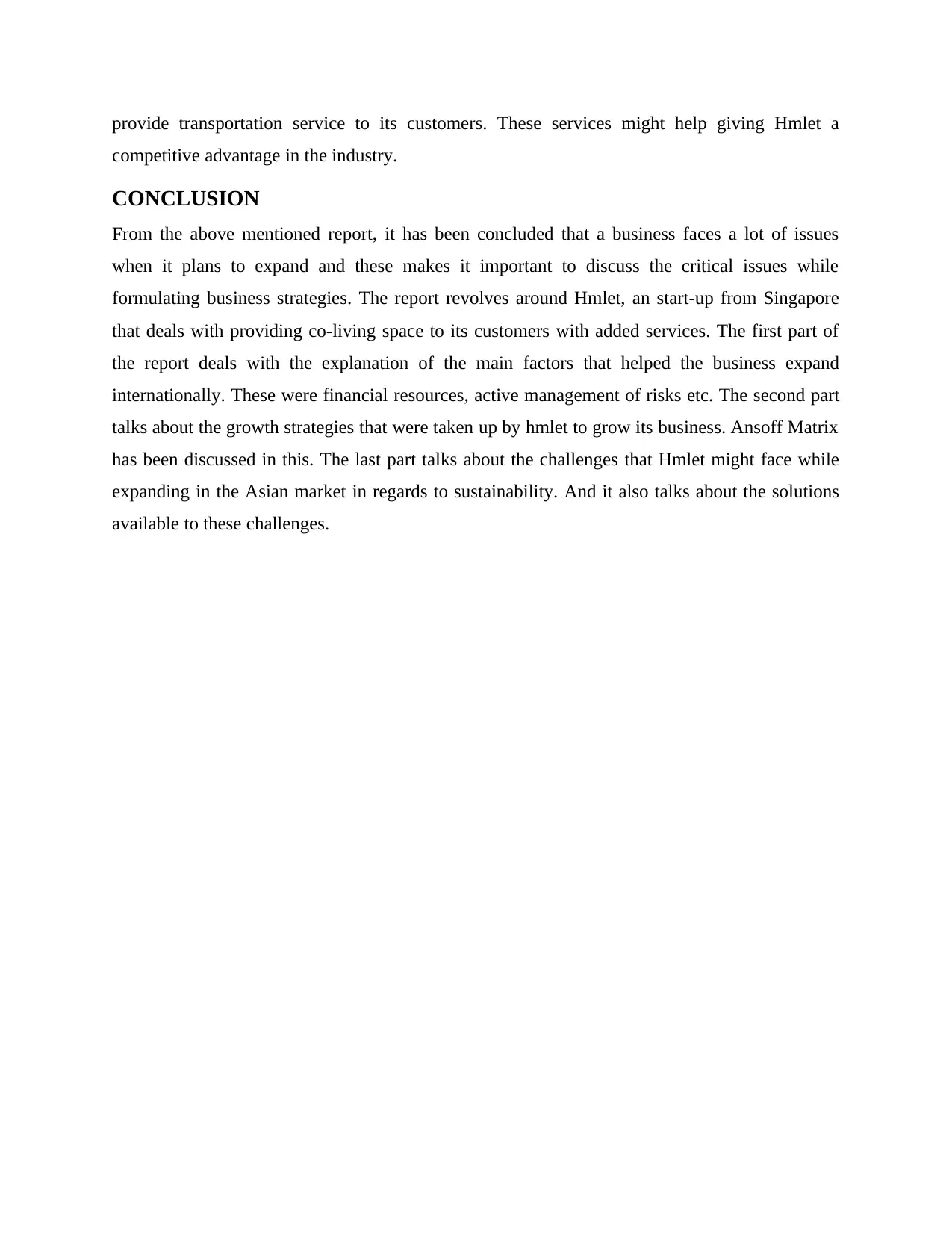
provide transportation service to its customers. These services might help giving Hmlet a
competitive advantage in the industry.
CONCLUSION
From the above mentioned report, it has been concluded that a business faces a lot of issues
when it plans to expand and these makes it important to discuss the critical issues while
formulating business strategies. The report revolves around Hmlet, an start-up from Singapore
that deals with providing co-living space to its customers with added services. The first part of
the report deals with the explanation of the main factors that helped the business expand
internationally. These were financial resources, active management of risks etc. The second part
talks about the growth strategies that were taken up by hmlet to grow its business. Ansoff Matrix
has been discussed in this. The last part talks about the challenges that Hmlet might face while
expanding in the Asian market in regards to sustainability. And it also talks about the solutions
available to these challenges.
competitive advantage in the industry.
CONCLUSION
From the above mentioned report, it has been concluded that a business faces a lot of issues
when it plans to expand and these makes it important to discuss the critical issues while
formulating business strategies. The report revolves around Hmlet, an start-up from Singapore
that deals with providing co-living space to its customers with added services. The first part of
the report deals with the explanation of the main factors that helped the business expand
internationally. These were financial resources, active management of risks etc. The second part
talks about the growth strategies that were taken up by hmlet to grow its business. Ansoff Matrix
has been discussed in this. The last part talks about the challenges that Hmlet might face while
expanding in the Asian market in regards to sustainability. And it also talks about the solutions
available to these challenges.

REFERENCES
Books and Journals
Balasubramanian, S., and et. al., 2021. Construction Industry 4.0 and Sustainability: An
Enabling Framework. IEEE Transactions on Engineering Management.
Dawes, J., 2018. The Ansoff matrix: A legendary tool, but with two logical problems. But with
Two Logical Problems (February 27, 2018).
Gomez-Trujillo, A.M. and Gonzalez-Perez, M.A., 2020. What do we know about organizational
sustainability and international business?. Management of Environmental Quality: An
International Journal.
Judge, M., Warren-Myers, G. and Paladino, A., 2019. Using the theory of planned behaviour to
predict intentions to purchase sustainable housing. Journal of cleaner production. 215.
pp.259-267.
Lee, S., 2020. Role of social and solidarity economy in localizing the sustainable development
goals. International Journal of Sustainable Development & World Ecology. 27(1).
pp.65-71.
Lüdeke-Freund, F., and et. al., 2019. Research on sustainable business model patterns: status
quo, methodological issues, and a research agenda. In Sustainable Business Models (pp.
25-60). Palgrave Macmillan, Cham.
Oroh, A., 2019. Does an Environment Serving Organization Based View Support A Product
Market Strategy? A Firm Performance Analysis. In The 1st Workshop on Multimedia
Education, Learning, Assessment and its Implementation in Game and Gamification in
conjunction with COMDEV 2018. European Alliance for Innovation (EAI).
Ranasinghe, G., 2019. Barriers and drivers of SMEs’ internationalisation in emerging markets:
Study of Sri Lankan youth entrepreneurs. In International Entrepreneurship in
Emerging Markets: Nature, Drivers, Barriers and Determinants. Emerald Publishing
Limited.
Schmid, S., 2018. Internationalisation Strategies and Processes of the German Mittelstand.
In Key Success Factors of SME Internationalisation: A Cross-Country Perspective.
Emerald Publishing Limited.
Books and Journals
Balasubramanian, S., and et. al., 2021. Construction Industry 4.0 and Sustainability: An
Enabling Framework. IEEE Transactions on Engineering Management.
Dawes, J., 2018. The Ansoff matrix: A legendary tool, but with two logical problems. But with
Two Logical Problems (February 27, 2018).
Gomez-Trujillo, A.M. and Gonzalez-Perez, M.A., 2020. What do we know about organizational
sustainability and international business?. Management of Environmental Quality: An
International Journal.
Judge, M., Warren-Myers, G. and Paladino, A., 2019. Using the theory of planned behaviour to
predict intentions to purchase sustainable housing. Journal of cleaner production. 215.
pp.259-267.
Lee, S., 2020. Role of social and solidarity economy in localizing the sustainable development
goals. International Journal of Sustainable Development & World Ecology. 27(1).
pp.65-71.
Lüdeke-Freund, F., and et. al., 2019. Research on sustainable business model patterns: status
quo, methodological issues, and a research agenda. In Sustainable Business Models (pp.
25-60). Palgrave Macmillan, Cham.
Oroh, A., 2019. Does an Environment Serving Organization Based View Support A Product
Market Strategy? A Firm Performance Analysis. In The 1st Workshop on Multimedia
Education, Learning, Assessment and its Implementation in Game and Gamification in
conjunction with COMDEV 2018. European Alliance for Innovation (EAI).
Ranasinghe, G., 2019. Barriers and drivers of SMEs’ internationalisation in emerging markets:
Study of Sri Lankan youth entrepreneurs. In International Entrepreneurship in
Emerging Markets: Nature, Drivers, Barriers and Determinants. Emerald Publishing
Limited.
Schmid, S., 2018. Internationalisation Strategies and Processes of the German Mittelstand.
In Key Success Factors of SME Internationalisation: A Cross-Country Perspective.
Emerald Publishing Limited.
⊘ This is a preview!⊘
Do you want full access?
Subscribe today to unlock all pages.

Trusted by 1+ million students worldwide
1 out of 9
Related Documents
Your All-in-One AI-Powered Toolkit for Academic Success.
+13062052269
info@desklib.com
Available 24*7 on WhatsApp / Email
![[object Object]](/_next/static/media/star-bottom.7253800d.svg)
Unlock your academic potential
Copyright © 2020–2025 A2Z Services. All Rights Reserved. Developed and managed by ZUCOL.


